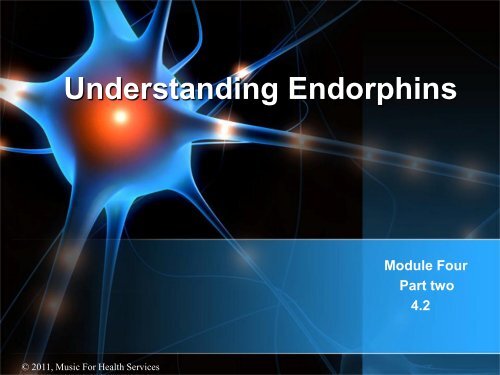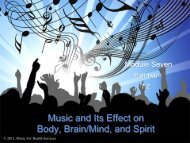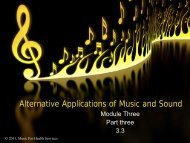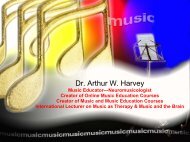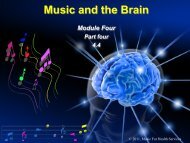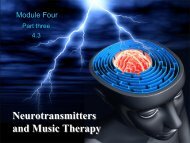Understanding Endorphins - Music for Health Services
Understanding Endorphins - Music for Health Services
Understanding Endorphins - Music for Health Services
- No tags were found...
You also want an ePaper? Increase the reach of your titles
YUMPU automatically turns print PDFs into web optimized ePapers that Google loves.
<strong>Understanding</strong> <strong>Endorphins</strong>Module FourPart two4.2© 2011, <strong>Music</strong> For <strong>Health</strong> <strong>Services</strong>
One of the often stated rationales <strong>for</strong> using music tomanage pain is its ability to stimulate endorphins.A brief clarification may help you to understand and beable to communicate about endorphins.
What are endorphins?• <strong>Endorphins</strong> areneurochemicals that actby modifying the way inwhich nerve cells respondto transmitters.• Endorphin (Endo-orphin)means “endogenousmorphine” or “morphinelike substance originatingfrom within the body”.
Kinds of endorphins• There are 20 different kinds of endorphins.• The three most common are beta-endorphins, enkephalins anddynorphins.• Endorphin and enkephalin are the body's natural painkillers. When aperson is injured, pain impulses travel up the spinal cord to the brain.The brain then releases endorphins and enkephalins. Enkephalins blockpain signals in the spinal cord. <strong>Endorphins</strong> are thought to block painprincipally at the brain stem. Both are morphine-like substances whosefunctions are similar to those of opium-based drugs.• Today, the word "endorphin" is used generically to describe both groupsof painkillers. These naturally occurring opiates include enkephalins(methionine and leucine), endorphins (alpha, beta, gamma, and delta)and a growing number of synthetic (artificial) compounds.
Where do they come from?• Beta-endorphins areproduced in thepituitary gland.• Enkephalins anddynorphins are bothproduced in thenervous system.
EnkephalinsEnkephalins are neurotransmitters which work to suppresspain. The goal of pain suppression is to allow the body to copewith pain while remaining focused, rather than permitting theperception of pain to flood the system and cause panic, distress,or confusion. These neurotransmitters are polypeptides,meaning that they consist of very short chains of amino acids.Two different enkephalins have been identified: met-enkephalinand leu-enkephalin. An enkephalin is a pentapeptide involved inregulating nociception in the body. The enkephalins are termedendogenous ligands, or specifically endorphins, as they areinternally derived and bind to the body's opioid receptors.Discovered in 1975.
Interesting fact about their discovery• <strong>Endorphins</strong> were discovered after scientistsfound that the pain reliever morphine already fita certain nerve cell structure in the brain.• This meant the brain was already producing apain killer of its own which was later discoveredand named “endogenous morphine”.
Facts about endorphins<strong>Endorphins</strong> are endogenous opioid polypeptidecompounds. They are produced by the pituitary glandand the hypothalamus in vertebrates during exercise,excitement, pain, consumption of spicy food andorgasm, and they resemble the opiates in their abilitiesto produce analgesia and a feeling of well-being.<strong>Endorphins</strong> work as "natural pain relievers."The term "endorphin" implies a pharmacologicalactivity (analogous to the activity of the corticosteroidcategory of biochemicals) as opposed to a specificchemical <strong>for</strong>mulation.
<strong>Endorphins</strong>It consists of two parts: endo- and -orphin; these areshort <strong>for</strong>ms of the words endogenous and morphine,intended to mean "a morphine-like substanceoriginating from within the body."The term endorphin rush has been adopted in popularspeech to refer to feelings of exhilaration brought onby pain, danger, or other <strong>for</strong>ms of stress, supposedlydue to the influence of endorphins. When a nerveimpulse reaches the spinal cord, endorphins arereleased which prevent nerve cells from releasingmore pain signals. Immediately after injury,endorphins allow animals to feel a sense of power andcontrol over ...
What do endorphins do?• Relieve pain• Enhance immune system• Reduce stress levels• Postpone aging process• Modulate appetite• Lowers blood pressure• Influences calm or euphoric state of mind
Natural pain killer• Damage detecting sensoryneurons relay messages of pain tothe spinal cord.• When a nerve impulse reaches thespinal cord, endorphins arereleased; this prevents nerve cellsfrom sending pain signals(substance P) to the brain.
Boost immune system• When endorphins aresecreted, they alsoactivate Natural Killercells (NK cells) whichtake responsibility <strong>for</strong> theimmune system by killingdefective cells.Natural Killer (NK) cell image(Credit: SUNY Upstate MedicalUniversity)• NK cells also have abilityto modify cancer cells.
What causes endorphin release?• Pain• Stress• Foods such as chocolate and chilipeppers• Overexposure to sunlight• Exercise• Laughter• <strong>Music</strong>
Pain and Stress• Pain and stress are the two most common factorsleading to the release of endorphins.• It is believed that under extreme stress, or pain,endorphins work over time and can be credited withsuch things as the “adrenaline rush”, “runnershigh”, and “second wind”.• <strong>Music</strong> can often serve as a ‘sonic caffeine’ whichcan activate mental and physical states.
Eating spicy foods• Capsaicin, the active chemical inred chili peppers, has been shownto stimulate endorphin release.• A topical capsaicin cream hasbeen used as a treatment <strong>for</strong>certain types of chronic pain.Do you think that listening to“Red Hot Chili Peppers” will helpyou release endorphins?
<strong>Endorphins</strong> in therapy<strong>Endorphins</strong> ability toalleviate pain, enhancethe immune system,reduce stress, relaxmind/body and lowerblood pressure make ita vital tool in manykinds of therapyincluding music andlaughter therapy.
Endorphin release is• Safe• Without side effect• Non-addictive• Relaxing• Free (in most cases)• An awesome natural high
<strong>Music</strong> and <strong>Endorphins</strong>Dr. Mitchell L. Gaynor, director of medical oncologyand integrative medicine at New York Hospital'scancer-prevention center, and author of the bookSounds of Healing writes. “It (sound & music) alsotrims complications after heart attack, calms anxiety,slows breathing and increases production ofendorphins, the body's natural painkillers. Consider:80% of stimuli that reach our brains come in throughour ears”.
<strong>Music</strong> and <strong>Endorphins</strong><strong>Endorphins</strong>: Strong painkillers. (article)http://tobein<strong>for</strong>med.com/health-articles/endorphins--strong-painkillers-yoursubconscious-may-be.htmlHow to release endorphins.http://www.ehow.com/how_2063616_release-endorphins.html<strong>Music</strong>, Emotion and the Brain. (article)http://serendip.brynmawr.edu/bb/neuro/neuro04/web2/gvaidya.htmlWhat makes singing fun. (article)http://cmv.customer.customer.netspace.net.au/WhatMakesItFun.htmlPBS Online: A Science Odyssey: People and Discoveries. PublicBroadcasting System (1998-01-01). Role of endorphins.http://www.pbs.org/wgbh/aso/databank/entries/dh75en.html


